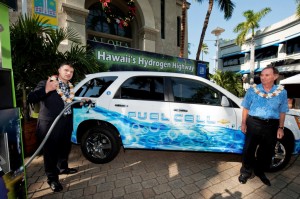
General Motors Executive Charlie Freese (left) hooks a hydrogen dispenser to a Chevy Equinox. The Gas Company President Jeff Kissel Observes.
Ten companies, agencies and universities have joined The Gas Company (TGC), and General Motors to make hydrogen-powered vehicles and a fueling infrastructure a reality in Hawaii by 2015. Taxpayers are subsidizing the program through several government agencies.
Hawaii could benefit from hydrogen-powered fuel cell vehicles because it depends on imported petroleum for 90% percent of its energy use. Gasoline prices are among the highest in the U.S. and electricity prices are the highest.
However, fuel cells continue to face many, many challenges, including extremely high costs for both the energy and the fuel cell vehicle, as well as limited range. One solution to overcome range anxiety is under development at GM to allow for 300 miles between refills, but it requires large, high-pressure hydrogen tanks (700 bar, 128 Kg in weight!), which can take up much of the usable space of a car.
The state of Hawaiian wants to reduce petroleum use by 70% within a generation by switching to a combination of renewable energy resources, as well as increasing conservation and efficiency.
The plan, called the Hawaii Hydrogen Initiative (H2I), wants to use hydrogen as an essential building block for Hawaii’s sustainable energy ecosystem. This effort to reduce the state’s dependence on imported oil is expected to make hydrogen available to all of Oahu’s 1 million residents by 2015. The goal is for 20 to 25 hydrogen stations to be installed in strategic locations around the island.
The plan builds on a May 2010 memorandum of understanding between TGC, one of Hawaii’s major utilities, and GM. TGC today produces enough hydrogen to power up to 10,000 fuel cell vehicles and has the capacity to produce much more hydrogen. GM is a leader in hydrogen fuel cell vehicles and fielded the world’s largest fuel cell demonstration fleet – more than 100 vehicles – beginning in 2007.
The hydrogen initiative partners are evaluating methods to distribute hydrogen through existing natural gas pipelines, addressing the long-standing problem of how to cost effectively produce and distribute hydrogen.
“Hydrogen, used as a fuel, will reduce our dependence on petroleum starting today,” said Jeff Kissel, TGC president and CEO.
GM’s electric Chevrolet Equinox, arguably the most advanced hydrogen vehicle at this time, runs on electricity created by an on-board fuel cell stack similar to ones used the space program and they are about as expensive.
The U.S. Department of Energy estimated in 2008 that in volume production electricity would be made at $73 a kilowatt. A kilowatt hour (KWh) of electricity in Michigan for residential customers costs 15 cents or less.
In spite of the enormous technical challenge, the attraction of a fuel cell is that the only emissions created are water vapor — if you do not take into account how the hydrogen fuel is created that the Chevrolet fuel cell uses.
GM has the world’s largest market test and demonstration fleet of fuel cell electric vehicles in use, and since 2007 and it has tallied nearly 1.3 million miles of driving in cities around the world.


